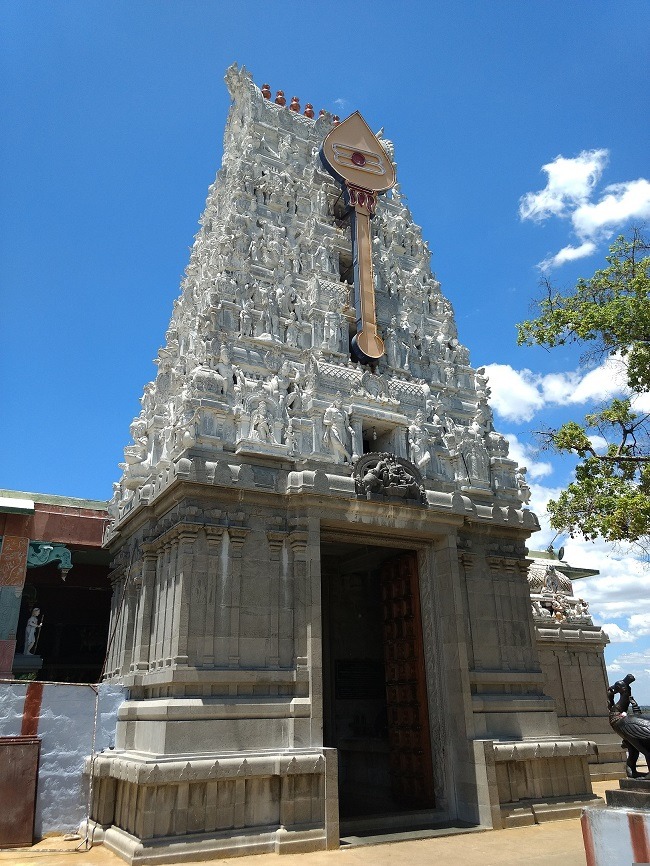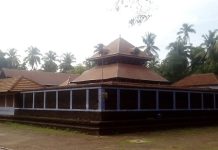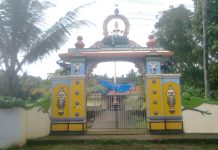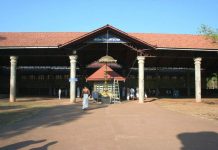Pachaimalai Arulmigu Subramanyaswamy Temple, also known as the Pachaimalai Balamurugan Temple, is one of the two major hill temples located in Gobichettipalayam, Tamil Nadu, India, and is dedicated to the Lord Murugan.
The name Pachaimalai is derived from the Tamil words “pachai” meaning green and “malai” meaning hill. The temple got its name from the presence of a spring beneath the presiding deity at the sanctum sanctorum. It is also fascinating to note the similarities between the Pachaimalai temple and the Palani temple, both of which have Lord Murugan in the form of Bala Dhandayuthapani, shrines that face towards west, and Kadamba Tree as the temple tree.
It is remarkable that even during the drought years of 2001 to 2005, when the wells in the surrounding areas went dry, water was still available on top of the hill where the temple is located. The availability of water even during drought years has made the Pachaimalai hill a source of great reverence for the local people, who consider it a sacred site.
Legend of Pachaimalai Subramanya Swamy Temple
According to legend, Saint Durvasa’s mystical powers led him to Modachur, a village near Gobichettipalayam, where he undertook a penance on Lord Shiva. However, he also desired to see Lord Murugan and received guidance from Lord Shiva to visit Pachaimalai, a small hillock nearby. There, he worshipped Sri Murugan as Dhandayuthapani and installed a statue of him facing west.
Later, while offering his prayers to Lord Shiva at Modachur, Saint Durvasa wished to have a darshan of Lord Subramanya. Following Lord Shiva’s advice, he discovered the small hillock where he installed Lord Subramanya as Balakurama, facing west.
This legend showcases the devotion of Saint Durvasa towards Lord Shiva and Lord Murugan, as well as the significance of guidance and intuition in spiritual practices. It also highlights the belief in the divine presence in natural landscapes such as hillocks and mountains.
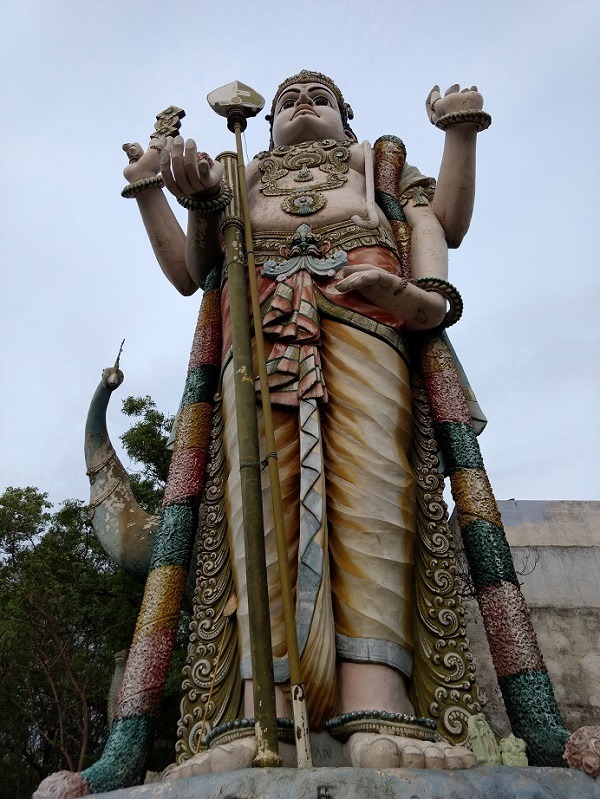
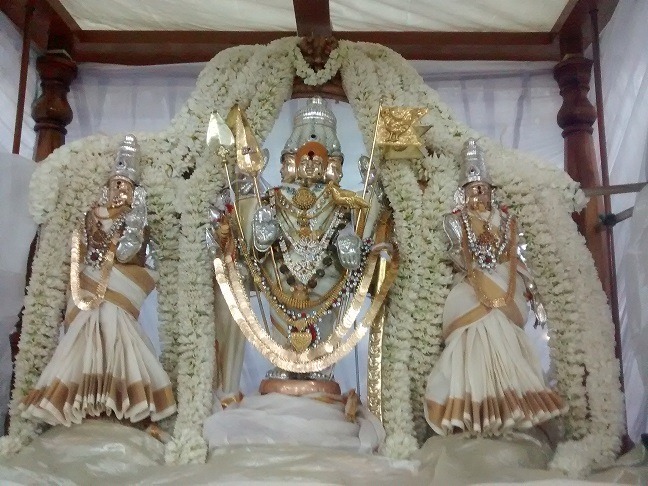
History of Pachaimalai Subramanya Swamy Temple
The temple is believed to be over 3000 years old, indicating the ancient roots of the worship of Lord Murugan in the region. In 1954, Amarar. P. K. Kuppusamy Gounder saw a divine light emanating from the sanctum sanctorum of the temple and decided to restore it. He started regular poojas and codified the practices and events at the temple. As a result of his efforts, the temple was completely rebuilt by 1980.
Architecture of Pachaimalai Subramanya Swamy Temple
The Dravidian style of architecture is known for its ornate and intricate designs, and the five-story Gopuram of the temple is a prominent feature that adds to its grandeur.
The presiding deity of the temple, Balamurugan, is believed to be the child form of Lord Murugan, and the statue measuring 40 feet is one of the largest Senthil Andavar statues in the state. It’s interesting to note that the deity faces west, which is considered unusual in Hindu temple architecture where the deities usually face east.
The temple also houses several other shrines dedicated to various gods and goddesses, including Vidya Ganapathy, Maragatheeswarar and His consort Maragathavalli, Kalyana Subramanyar with His consorts Valli and Deivanai, Maragatha Venkatesa Perumal with His consorts Sridevi and Bhoodevi, Dakshinamurthi, Bhairavar, and the Navagraha.
It’s also noteworthy that at Pachaimalai, the Navagrahas can be seen with their consorts seated on their respective mounts, which is considered unusual and adds to the uniqueness of the temple.
Overall, the temple at Pachaimalai is a significant pilgrimage site for devotees of Lord Murugan and other deities, and its architecture and intricate designs make it a fascinating example of Dravidian style temple architecture.
Festivals of Pachaimalai Subramanya Swamy Temple
The Pachaimalai Subramanya Swamy Temple hosts several festivals throughout the year, which are celebrated with great enthusiasm and devotion. The most significant festival of the temple is the Brahmotsavam festival, celebrated during the Tamil month of Panguni (March-April). The festival spans seven days, culminating in the grand celebration of Panguni Uthiram, which sees thousands of devotees visiting the temple to offer their prayers and participate in the festivities. The festival features a procession of Lord Kalyana Subramanyar around the hill on the first six days, riding different mounts such as the Bootha Vahanam, Yaanai Vahanam, Rishaba Vahanam, Annapatchi Vahanam, and Attukidai Vahanam. On the sixth day, the Thiru Kalyana Utsavam is performed, and the deity graces the wooden chariot. The festival’s highlight, Panguni Uthiram, witnesses the temple’s massive chariot being run, and Annadhanam is conducted to feed the devotees.
Another significant festival is the Skanda Shasti Soorasamharam festival, held during October-November, to celebrate the victory of good over evil. The deity, mounted on an elephant, presides over the function to defeat and give salvation to Soorapadman, the personification of ego. The festival involves the Deity and devotees undertaking the Kandar Shasti Viratham, a fast for seven days, which ends with the Thirukalyana Utsavam.
The Thai Poosam festival is another prominent festival celebrated in the temple during January-February. The festival features Kavadi abishekam in the first half of the day, while the presiding deity of the temple graces in Thanga Kavasam, the golden Kavacha, during the latter part of the day.
Other festivals celebrated in the temple include the Vaikaasi Visaagam Lacharchanai, which is conducted for three days during May-June, featuring a grand abishekam for the deity on the final day. The temple’s Karthigai Deepam Festival is also a significant celebration held during November-December. Overall, the temple’s festivals are an essential part of its cultural and religious identity, attracting devotees from far and wide.
Temple Timings – Pachaimalai Subramanya Swamy Temple
The Pachaimalai Subramanya Swamy Temple is open every day from 6:00 AM to 1:00 PM and then again from 4:00 PM to 8:00 PM. Visitors are welcome to come and offer their prayers during these hours.
How to reach Pachaimalai Subramanya Swamy Temple
Pachaimalai Subramanya Swamy Temple is located in the town of Gobichettipalayam in Tamil Nadu, India. The temple is easily accessible by road and rail.
By Air:
The nearest airport to the temple is Coimbatore International Airport, which is located about 83 km away. Coimbatore International Airport is well-connected to major cities in India and other countries. From the airport, visitors can hire a taxi or take a bus to reach the temple.
By Rail:
The nearest railway station to the temple is Erode Junction, which is located about 38 km away. Erode Junction is well-connected to major cities in Tamil Nadu and other parts of India. From the railway station, visitors can hire a taxi or take a bus to reach the temple.
By Road:
Gobichettipalayam is well-connected to various cities and towns in Tamil Nadu by road. The temple is located about 4 km from the town center, and visitors can easily hire a taxi or an auto-rickshaw to reach the temple.


























